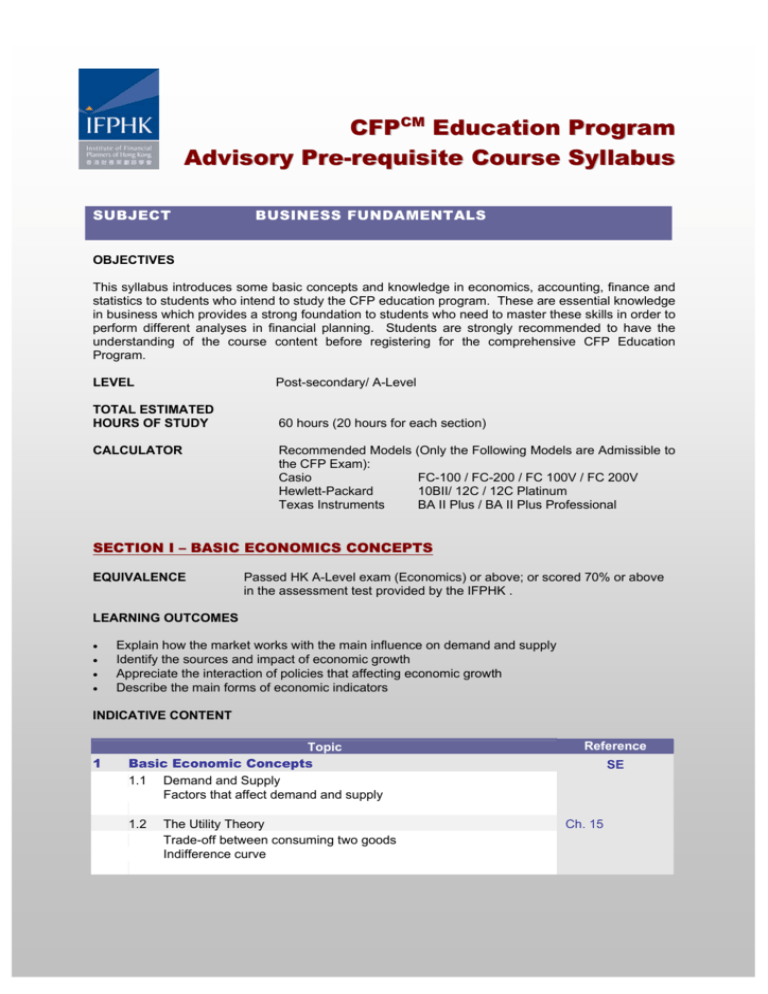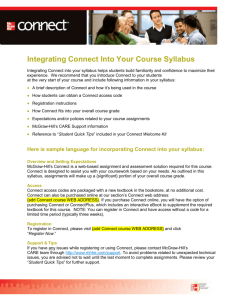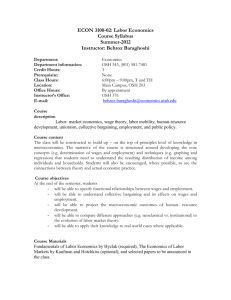
CFPCM Education Program
Advisory Pre-requisite Course Syllabus
SUBJECT
BUSINESS FUNDAMENTALS
OBJECTIVES
This syllabus introduces some basic concepts and knowledge in economics, accounting, finance and
statistics to students who intend to study the CFP education program. These are essential knowledge
in business which provides a strong foundation to students who need to master these skills in order to
perform different analyses in financial planning. Students are strongly recommended to have the
understanding of the course content before registering for the comprehensive CFP Education
Program.
LEVEL
Post-secondary/ A-Level
TOTAL ESTIMATED
HOURS OF STUDY
60 hours (20 hours for each section)
CALCULATOR
Recommended Models (Only the Following Models are Admissible to
the CFP Exam):
Casio
FC-100 / FC-200 / FC 100V / FC 200V
Hewlett-Packard
10BII/ 12C / 12C Platinum
Texas Instruments
BA II Plus / BA II Plus Professional
SECTION I – BASIC ECONOMICS CONCEPTS
EQUIVALENCE
Passed HK A-Level exam (Economics) or above; or scored 70% or above
in the assessment test provided by the IFPHK .
LEARNING OUTCOMES
•
•
•
•
Explain how the market works with the main influence on demand and supply
Identify the sources and impact of economic growth
Appreciate the interaction of policies that affecting economic growth
Describe the main forms of economic indicators
INDICATIVE CONTENT
1
Topic
Basic Economic Concepts
1.1 Demand and Supply
Factors that affect demand and supply
1.2
The Utility Theory
Trade-off between consuming two goods
Indifference curve
Reference
SE
Ch. 15
ADVISORY PRE-REQUISITE COURSE SYLLABUS
Topic
Reference
Ch. 4
1.3
Gross Domestic Product
Factors that affect the GDP
1.4
Interest Rate, Savings, and Investment
Ch. 9, 10
1.5
Inflation
Real growth and inflation
Ch. 5
1.6
Employment
Factors that affect unemployment rate
Unemployment and GDP
Ch. 5
1.7
Fiscal and Monetary Polices
Effects of tax and government spending on the economy
The role of central bank and monetary policy
Ch. 8, 11
1.8
Business Cycles
Stages of business cycle
1.9
Economic Indicators
Leading indicators
Coincident indicators
Lagging indicators
REFERENCE MATERIALS
(SE)
Salvatore Dominic, Schaum's Easy Outline of Principles of Economics, McGraw-Hill, latest
edition
Bodie, Kane, and Marcus, Essentials of Investments, McGraw-Hill, latest edition, Ch. 11
Economics Basics Tutorial, http://www.taxopedia.com/university/economics/
Copyright 2004. The Institute of Financial Planners of Hong Kong Limited. All rights reserved.
2
ADVISORY PRE-REQUISITE COURSE SYLLABUS
SECTION II – BASIC ACCOUNTING AND FINANCE
EQUIVALENCE
Scored 70% or above in the assessment test provided by the IFPHK
LEARNING OUTCOMES
•
•
•
•
Explain the need for financial statements as well as the preparation for it
Identify the basics of financial statement
Describe the elements of balance sheet and statement of cash flow
Realize how to interpret accounting information and financial ratios
INDICATIVE CONTENT
Topic
1
2
Reference
Financial Statements
1.1 Balance Sheet
Assets and Liabilities
Equity and net worth
F Ch. 2
1.2
Income Statement
Revenue and expenditure
Cash items and non cash items
F Ch. 2
1.3
Cash Flow Statement
Cash flow from operation
Cash flow from investment
Cash flow from financing
F Ch. 15
Financial Ratios
2.1 Leverage Ratios
2.2 Turnover and Other Asset Utilization Ratios
2.3 Liquidity and Coverage Ratios
2.4 Profitability Ratios
2.5 Market Price Ratios
F Ch. 14
REFERENCE MATERIALS
(F)
Shim & Siegel, Schaum's Financial Accounting, McGraw-Hill, latest edition
Business Basics for the Workplace, Participant Workbook, Conference Board of Canada,
http://www.conferenceboard.ca/busbasics/pdf/wkbk.pdf
Copyright 2004. The Institute of Financial Planners of Hong Kong Limited. All rights reserved.
3
ADVISORY PRE-REQUISITE COURSE SYLLABUS
SECTION III – MATHEMATICS FOR BUSINESS
EQUIVALENCE
Scored 70% or above in the assessment test provided by the IFPHK
LEARNING OUTCOMES
Understand basic mathematics commonly apply to financial planning
Define the concepts of time value of money and understand how to calculate time value of money
Understand the usage of basic statistical concepts in computing the risk and return
•
•
•
INDICATIVE CONTENT
Topic
1
Interest Calculation
1.1 Simple Interest
1.2 Compound Interest
Discrete compounding periods
Continuous compounding
1.3 Interest Rate Quotation
Annual percentage rate (APR)
Effective annual rate (EAR)
Flat rate
2
Time Value of Money
2.1 Present Value
2.2 Future Value
2.3 Annuity
3
Statistics
3.1 Probability (Normal Distribution) and Expected Value
Definition of probability
3.2 Weighted Average
3.3 Variance, Standard Deviation, and Covariance
Meaning of risk
Reference
M Ch. 3, 4, & 5
M Ch. 3, 4, & 5
S Ch. 6
S Ch. 3 & 4
REFERENCE MATERIALS
(M)
Zima & Brown, Schaum's Outline of Mathematics of Finance, McGraw-Hill, latest edition
(S)
Lind, Marchal, Mason, Statistical Techniques in Business & Economics, McGraw- Hill, latest
edition,
Copyright 2004. The Institute of Financial Planners of Hong Kong Limited. All rights reserved.
4








